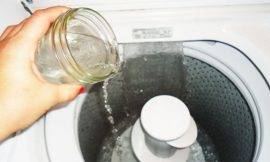
Did you know that your washing machine can be a breeding ground for mold and mildew? Recent studies show that nearly 60% of washing machines harbor bacteria, which can lead to unpleasant odors and health risks! It’s crucial to understand how often you should clean your washing machine to avoid these issues. In this article, we will dive into effective cleaning schedules, simple maintenance tips, and the best practices to keep your washer mold-free and functioning at its best. With just a little effort, you can ensure your clothes come out fresh and clean every time!
Understanding Mold Growth in Washing Machines
Mold and mildew are types of fungi that can thrive in damp environments, and washing machines provide an ideal habitat, especially when left unmaintained. Mold appears as dark, fuzzy spots and can develop in areas where moisture accumulates, like around seals, dispensers, and drum interiors.
Several factors contribute to mold growth in washing machines. High humidity levels, poorly ventilated laundry rooms, and the residual moisture that lingers after a wash cycle create a perfect storm for mold and mildew. Additionally, using too much detergent or fabric softener can lead to build-up, providing more surfaces for mold to thrive.
If your washing machine has developed a musty smell, visible spots of mold, or you notice that your clothes come out smelling off, these are common symptoms of a moldy washing machine. In some cases, you may also notice a discoloration on the rubber seal or around the detergent dispensers.
Recommended Cleaning Frequency
How often you should clean your washing machine largely depends on how frequently you use it. If you wash laundry multiple times a week, a monthly cleaning might be necessary. However, if your washing machine sees less action, consider cleaning it every few months.
There is also a difference in cleaning frequency based on the type of washing machine you have. Front-load washers are typically more prone to mold growth due to the way they seal and their design, so you may need to clean them more often than top-load washers, which generally allow for better ventilation.
Seasonal changes can also affect your cleaning schedule. In humid months, like summer, mold can become more problematic. So, during warmer times of the year, increase your cleaning frequency to help prevent build-up.
How to Properly Clean Your Washing Machine
Let’s dive into the step-by-step process for cleaning your washer.
Cleaning a Front-Loader
- Gather Supplies: You’ll need white vinegar, baking soda, and a soft cloth or sponge.
- Wipe Down the Door Seal: Carefully clean around the rubber door seal, where moisture often settles.
- Run a Cleaning Cycle: Pour two cups of vinegar into the drum and run a hot wash cycle.
- Add Baking Soda: After the vinegar cycle, add a cup of baking soda and run another hot cycle.
- Rinse: Wipe down the inside of the drum with a damp cloth after the cycle finishes.
- Leave the Door Open: Allow the machine to dry out completely to prevent future mold growth.
Cleaning a Top-Loader
- Gather Supplies: You’ll need bleach or vinegar, and a soft cloth.
- Set the Machine to Soak: Fill the machine with hot water and add a quart of bleach (or two cups of vinegar). Let it soak for an hour.
- Agitate: After soaking, run the appliance on the longest cycle available to agitate.
- Repeat: Once the cycle finishes, run another rinse cycle to ensure all cleaning agents are removed.
- Wipe Down: Use a cloth to wipe around the lid and the top of the drum.
- Leave Open to Dry: Just like with front-loaders, keep the lid open for a while to promote drying.
Recommended Cleaning Products and Natural Alternatives
While you can use commercial washing machine cleaners available in the market, natural alternatives like white vinegar and baking soda are effective, eco-friendly options that can help break down mold and mildew without harsh chemicals.
Tips for Preventing Mold in Your Washing Machine
Keeping mold at bay in your washing machine involves adopting some best practices. One important tip is to leave the door open after doing laundry. This simple action allows air to circulate and reduce moisture levels inside the machine. Additionally, regularly drying the rubber gasket helps to prevent moisture accumulation.
Moreover, it's vital to use the right detergent—too much, or the wrong type can create suds that trap water and lead to mold. Opt for HE (high-efficiency) detergents for front-loaders and avoid fabric softeners if possible.
Managing humidity in your laundry space can further help. Use a dehumidifier or ensure there's good airflow in the area where your washer is located.
Recognizing When to Call a Professional
While routine cleaning can often prevent mold issues, there are signs that indicate you might need to call a professional. If you notice persistent mold odors, or if you've cleaned the machine without a significant improvement, these are red flags. Professionals can perform a deeper inspection and cleaning to address hidden mold issues within the machine or the plumbing.
Severe mold cases can be challenging to handle on your own. Professional services have specialized tools and solutions to effectively eradicate mold and prevent it from returning. Additionally, regular maintenance services can be a wise choice for preventing future occurrences of mold in your washing machine, ensuring it runs efficiently and stays hygienic.
Conclusion
In conclusion, maintaining a clean washing machine is crucial to prevent mold and extend its lifespan. By following our recommended cleaning schedule, incorporating the right techniques, and adopting proactive measures, you can keep your washer in pristine condition! Don't wait for the smell of mildew to hit—make washing machine cleaning a regular part of your household routine. Take the first step today and enjoy fresher laundry!






